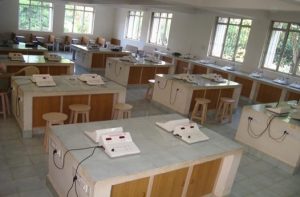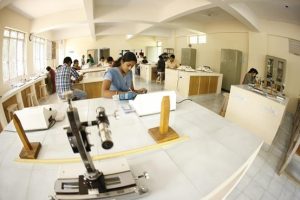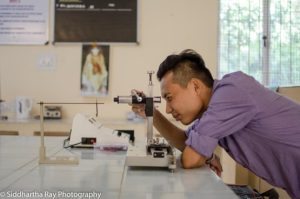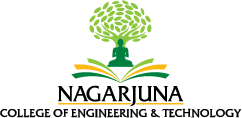- About Course
- Vision & Mission
- HoD's Message
- Faculty
- Objectives
- Board Of Studies
- Scheme&Syllabus
- Facilities
- First Year Faculty (Last 3 Years)
Courses offered by the department:
1. Applied Physics for CSE Stream
Applied Physics for CSE stream is a 4 credit integrated course with 5 modules. The syllabus is designed in such a way that it caters to all the allied branches of computer science and engineering such as ISE, Data science and AI&ML. This Course covers the fundamental of Physics and its applications. Understand the idea of Simple harmonic motion, shock waves, numerical aperture of optical fiber, concept of damped, forced vibrations and quantization of energy.
Apply the concept of resonance for tuning systems, shock waves in various fields, optical fibers in communication systems, failure of classical free electron theory, importance of lasers its applications, and importance of quantum computing. This course is to make the students gain practical knowledge to co-relate with the theoretical studies and also achieve perfectness in experimental skills. The study of practical applications will bring more confidence and ability to develop and fabricate engineering and technical equipment’s. Design of circuits using new technology and latest components and to develop practical applications of engineering materials and use of principle in the right way to implement the modern technology.
2. Applied Physics for Civil engineering.
Applied Physics for Civil engineering is a 4 credit integrated course with 5 modules. The syllabus is designed in such a way that it caters to the need of Civil engineering students. The course coves the fundamentals of Laser and its applications. Various concepts of quantum mechanics including quantization of energy and applications of Schrodinger wave equation. Understand the idea of Simple harmonic motion, shock waves, numerical aperture of optical fiber and concept of damped, forced vibrations.
Understand the applications of shock waves in various fields, optical fibers in communication systems. Analyze the importance of sharpness of resonance, failure of classical free electron theory, importance of laser its application, the concept of elasticity. The elastic properties of materials, stress strain diagram, fatigue, fracture point etc.
This course is to make the students gain practical knowledge to co-relate with the theoretical studies and also achieve perfectness in experimental skills. The study of practical applications will bring more confidence and ability to develop and fabricate engineering and technical equipment’s. Design of circuits using new technology and latest components and to develop practical applications of engineering materials and use of principle in the right way to implement the modern technology
3. Applied Physics for Electronics and engineering.
Applied Physics for Electronics and engineering is a 4 credit integrated course with 5 modules. The syllabus caters to the need of Electronics and communication engineering students. Apply the concept of resonance for tuning systems, shock waves in various fields, optical fibers in communication systems. Analyze the importance of sharpness of resonance, failure of classical free electron theory, Fermi energy, Fermi factor etc.
The course covers the fundamentals of Laser and its applications. Various concepts of quantum mechanics including quantization of energy and applications of Schrodinger wave equation. Understand the idea of Simple harmonic motion, shock waves, numerical aperture of optical fiber and concept of damped, forced vibrations.
This course is to make the students gain practical knowledge to co-relate with the theoretical studies and also achieve perfectness in experimental skills. The study of practical applications will bring more confidence and ability to develop and fabricate engineering and technical equipment’s. Design of circuits using new technology and latest components and to develop practical applications of engineering materials and use of principle in the right way to implement the modern technology
Vision
Leadership & Excellence in Education
Mission
“To fulfill the vision by imparting total quality education replete with the philosophy of blending human values and academic professionalism”
HoD's Message

Prof. Sharada T
Head of the Department
Physical Sciences are the foundation for all Engineering disciplines therefore a sound and application-oriented understanding in Physics is a pre-requisite for the study of any branch of Engineering. The department of physics intends to bestow knowledge to engineering students on various fruitful aspects of basic science. Physics forms a platform for the engineering students in understanding of other subjects of different streams of engineering and technology.
The department of Physics plays a vital role in the overall development of the students. The Department has well-educated, motivated and dedicated faculty members. Faculty members have produced high quality research with national and international publications in peer reviewed journals. The faculty members of the department attend various seminars and workshops pertaining to the subject and bestow the same knowledge to the students to keep them in touch with the latest developments in the field of science and technology. Research and development in various fields of basic science can be considered as a key factor for the intense development in the field of technology in the present world. The Department of Physics has been recognized as research centre by VTU.
| Sl. No. | Name of Faculty | Qualification | Designation |
| 1. | Mrs. Sharada T | M. Sc. (Ph .D) | Sr. Asst. Professor & HOD |
| 2. | Dr. Mahesh K. K. | M Sc. Ph. D | Professor |
| 3. | Mrs. Archana B S | M. Sc.(Ph. D), MBA B Ed. | Asst. Professor |
| 4. | Mr. Raghunath S | M. Sc. B Ed. | Asst. Professor |
| 5. | Mr.Akshay J Mashelkar | M. Sc. B Ed. | Asst. Professor and Head of center for CL and E |
- Educate students in the fundamental subject of Physics preparing them for a career in Engineering at a professional level of study.
- To give our students the ability to apply scientific and engineering principles to identify, formulate and solve problems in analysis and design. In this pursuit, our students need to understand the basics of modern engineering tools and the role of experimentation and how to apply these methods appropriately.
- To provide adequate education in physics to have a basis for complete understanding of current and future scientific and technological developments.
Sl. No | Name | Description | Designation |
1. | Dr. Manjunatha K | Professor & HOD, Dept. of Chemistry, NCET | Chairman |
2. | Dr. Deepa H R | Professor & Head, Dept. of Physics, BNMIT, Bangalore, VTU Nominee | VTU Nominee |
3. | Dr. Ganesh Belwadi | General manager – analytical division. VACHICHEM INTERNATIONAL PRIVATE LIMITED. | Member |
4. | Dr. Vijay Kumar | Professor, Dept. of Mathematics, MSRIT. | Member |
5. | Dr. Nagesh K N | Professor & HOD, Dept. of Electronics & Communication Engineering, NCET | Member |
6. | Dr. M V Sarvesha | Professor & HOD, Dept. of Mathematics, NCET | Member |
7. | Prof. Sharada T | Asst. Prof. & HOD, Dept. of Physics, NCET | Member |
8. | Prof. Ramesh | HOD, SSFL, NCET | Member |
9. | Dr. Mahesh K K | Professor, Dept. of Physics | Member |
10. | Dr. Yogeesha HC | Assc. Director IQAC Professor & Head Dept. of Mechanical Engineering | Member |
11. | Dr. Pankaja K | Assc. Prof. & HOD, Dept. of CSE, NCET | Member |
12. | Dr. Sri lakshmi | Professor & HOD, Dept. of Civil, NCET | Member |
13. | Dr. Navya Rani | Assc. Prof. & Assistant dean R & D, NCET | Member |
14. | Mr. Ramesh Gowda | Asst. Prof. Dept. of Mathematics, NCET | Member |
15. | Mrs. Mamatha M | Asst. Prof., Dept. of Chemistry, NCET | Member |
Ist Semester
II Semester
Syllabus 2022-23
Sl.No | Name of the Experiment. |
1. | Wave length of Laser using grating. |
2. | LCR series. |
3. | LCR parallel. |
4. | Charging and discharging of a capacitor. |
5. | Photo diode Characteristics. |
6. | Black box (DM). |
7. | Fermi energy (DM). |
8. | Four probe method (VL). |
9. | Numerical aperture using optical fiber (VL). |
10. | Planck’s constant using LED’s (OE) |
Sl.No. | Name of the Experiment. |
1. | Wave length of Laser using grating. |
2. | LCR series. |
3. | LCR parallel. |
4. | Charging and discharging of a capacitor. |
5. | Photo diode Characteristics. |
6. | Torsional pendulum (DM). |
7. | Single Cantilever |
8. | Four probe method (VL). |
9. | Numerical aperture using optical fiber (VL). |
10. | Planck’s constant using LED’s (OE) |
Sl.No | Name of the Experiment. |
1. | Wave length of Laser using grating. |
2. | LCR series. |
3. | LCR parallel. |
4. | Charging and discharging of a capacitor. |
5. | Photo diode Characteristics. |
6. | Black box (DM). |
7. | Fermi energy (DM). |
8. | Four probe method (VL). |
9. | Numerical aperture using optical fiber (VL). |
10. | Planck’s constant using LED’s (OE) |
The department has a very spacious and well-equipped laboratory with a highly experienced and dedicated laboratory assistant.




